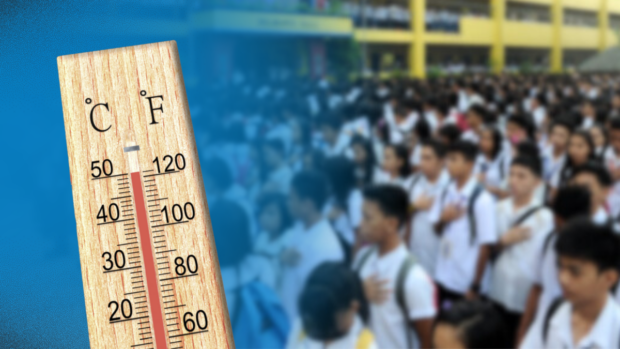
The heat index in 30 areas, including the Ninoy Aquino International Airport (Naia) and Science Garden in Quezon City, is predicted to soar to a “danger” level on Wednesday. INQUIRER file photo
MANILA, Philippines — The weather bureau warned that the heat index in 30 areas, including the Ninoy Aquino International Airport (Naia) in Pasay City and Science Garden in Quezon City, was forecast to reach the “danger” level on Wednesday.
Based on the prediction of the Philippine Atmospheric, Geophysical, and Astronomical Services Administration (Pagasa) as of 5 p.m. on Tuesday, these areas are:
Central Bicol State University of Agriculture in Pili, Camarines Sur – 46 degrees Celsius
San Jose, Occidental Mindoro – 45 degrees Celsius
Puerto Princesa City, Palawan – 45 degrees Celsius
Aborlan, Palawan – 45 degrees Celsius
Dagupan City, Pangasinan – 45 degrees Celsius
Aparri, Cagayan – 45 degrees Celsius
Naia, Pasay City – 44 degrees Celsius
Tuguegarao City, Cagayan – 44 degrees Celsius
Guiuan, Eastern Samar – 44 degrees Celsius
Science Garden, Quezon City – 43 degrees Celsius
Sangley Point, Cavite – 43 degrees Celsius
Central Luzon State University in Muñoz, Nueva Ecija – 43 degrees Celsius
Legazpi City, Albay – 43 degrees Celsius
Virac (Synop), Catanduanes – 43 degrees Celsius
Masbate City, Masbate – 43 degrees Celsius
Coron, Palawan – 43 degrees Celsius
Roxas City, Capiz – 43 degrees Celsius
Iloilo City, Iloilo – 43 degrees Celsius
La Granja, La Carlota, Negros Occidental – 42 degrees Celsius
Dumangas, Iloilo – 42 degrees Celsius
Daet, Camarines Norte – 42 degrees Celsius
Baler (Radar), Aurora – 42 degrees Celsius
Casiguran, Aurora – 42 degrees Celsius
Barangay Ambulong in Tanauan, Batangas – 42 degrees Celsius
Alabat, Quezon – 42 degrees Celsius
Isabela State University in Echague, Isabela – 42 degrees Celsius
Iba, Zambales – 42 degrees Celsius
Catbalogan, Samar – 42 degrees Celsius
Catarman, Northern Samar – 42 degrees Celsius
Tacloban City, Leyte – 42 degrees Celsius
READ: On-site classes suspended as ‘danger’ level heat index hits anew
Pagasa said temperatures ranging from 42 to 51 degrees Celsius fall under the “danger” category of heat indices.
People in areas under this category may experience heat cramps, exhaustion, and even heat stroke after drawn-out exposure to heat.
READ: 48ºC heat index hounds Aparri, Cagayan
To prevent the effects of sweltering weather, Pagasa said the public must limit time spent outdoors; drink plenty of water; avoid tea, coffee, soda, and liquor; use umbrellas, wear hats, and wear sleeved clothing outdoors; and schedule heavy-duty activities on the cooler periods of the day.
It added that symptoms of heat-related illnesses include heavy sweating, exhaustion or fatigue, dizziness or lightheadedness, blacking out or feeling dizzy when standing, a weak but fast pulse, nausea and vomiting.
In cases of emergency, Pagasa advises the following:
-Move the person to a shady spot and lie him or her down with legs elevated
-If conscious, have the person sip cool water
-Remove clothing. Apply cool water to the skin and provide ventilation
-Apply ice packs to the armpits, wrists, ankles and groin
-If the person’s condition worsens, immediately bring him/her to a hospital